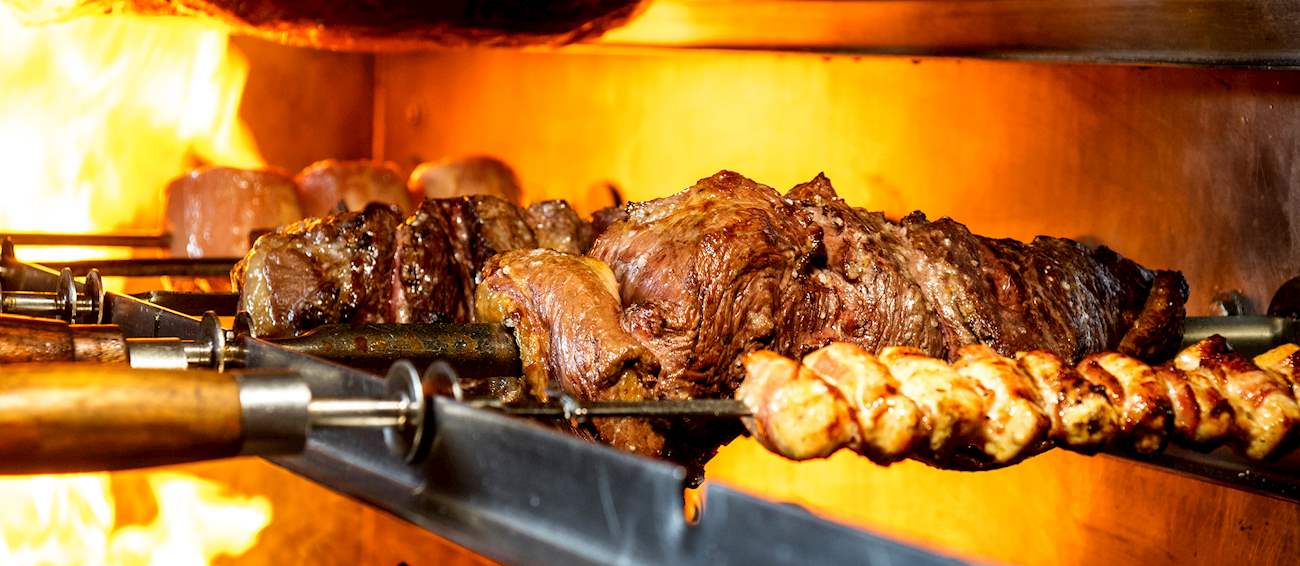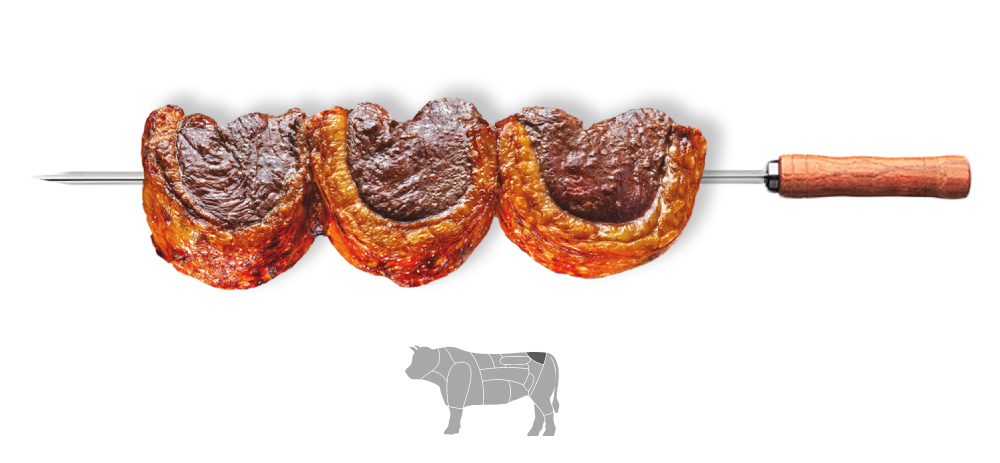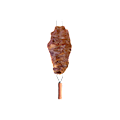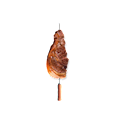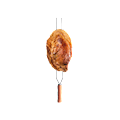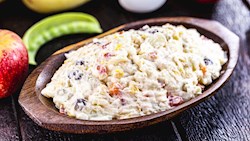MAIN INGREDIENTS
Picanha is a fresh cut of beef that's especially popular and highly prized in Brazil. In the US, it's called sirloin cap, and in the UK, it's known as the rump cap. Picanha is situated on the back side of the animal, above the butt, where it sits on a fat cap.
It's mostly used for churrasco – the meat is first grilled, then sliced off of a skewer. This cut holds very little fat in the meat, so it must be cooked perfectly in order not to make it tough. In Brazil, every churrasco has picanha, and all of the best churrascarias feature picanha on their menus.
OTHER VARIATIONS OF Churrasco
MOST ICONIC Picanha
View moreMAIN INGREDIENTS
Literally translated to cheese bread, pão de queijo has its origins in the culinary inventions of African slaves, when they started to use the residue of the cassava plant. A fine white powder, or starch, was rolled into balls and baked.
At the time, no cheese was added, so it was just baked starch, but at the end of the 19th century, when slavery ended, other foods started to become available to the Afro-Brazilians for the first time. In the state of Minas Gerais, the dairy center of Brazil, cheese and milk started to be added to the starchy balls, and pão de queijo was created.
MOST ICONIC Pão de queijo
View moreEscondidinho is a traditional casserole. It can be made with a variety of ingredients – beef, chicken, fish, pork, or shrimp. The original one is called escondidinho de carne seca, made with a combination of dried and salted meat and mashed potatoes.
The carne seca is cooked with tomatoes, onions, garlic, and various spices. It is placed into a baking dish, then topped with mashed potatoes, and often grated cheese. The combination is baked in the oven until golden brown on top. The name of the dish means little hidden one, referring to the meat hidden underneath a layer of mashed potatoes.
MAIN INGREDIENTS
In the American, French, German, Brazilian, and Korean systems of primal beef cuts, the tenderloin is a cut from the loin, which is located towards the back of the cow, nestled under the ribs, next to the backbone. It spans two primal cuts: the short loin and the sirloin.
The tenderloin is one of the most tender cuts of beef as it comes from a muscle that doesn't get much exercise. It is also one of the most highly prized and correspondingly expensive cuts of beef, due to its tenderness and flavor. Given the tenderness of this cut, the tenderloin is often cooked quickly over high heat, with methods such as grilling or broiling.
MAIN INGREDIENTS
In Brazilian cuisine, costela refers to a specific cut of beef known as ribs in English, although it differs from the American style ribs as it encompasses both ribs (costela do dianteiro) and ponta de agulha (plate ribs). It's a popular and essential component of Brazilian barbecue culture (churrasco).
Ribs are often skewered and grilled over an open flame to create flavorful and tender meat. It's seasoned with minimal ingredients like salt to enhance the natural flavors of the meat. The slow cooking process allows the meat to become tender and develop a delicious smoky flavor.
MAIN INGREDIENTS
In Brazilian cuisine, contrafilé refers to a specific cut corresponding to parts of the boneless strip loin and the ribeye. The term comes from Portuguese and literally translates to "against the grain," indicating the way the meat is typically sliced for cooking and serving.
Contrafilé is characterized by its marbling, tenderness, and rich flavor. The marbling of fat throughout the meat contributes to its juiciness and delicious taste when cooked. In Brazilian churrasco, the contrafilé is often skewered and grilled to perfection over an open flame.
MAIN INGREDIENTS
Tacacá is a mouth-numbing Brazilian soup made with large dried shrimps, tucupí (wild cassava byproduct), manioc starch, hot yellow peppers, and jambú – a leafy plant with anesthetic properties. To make tucupí, the juice extracted from a specific variety of sour cassava called mandioca brava (lit. angry cassava) is boiled, then left to ferment to eliminate the high levels of cyanide it possesses in its raw form.
After the fermentation process is over, the resulting sauce is distinguished by a yellowish color and an intensely acidic flavor. The mouth-numbing sensation of the soup comes from the jambú plant, which apart from being used in cooking, has also had a long tradition as a folk remedy in northern Brazil, especially in the states of Pará and Amazonas.
MAIN INGREDIENTS
Bife à Parmegiana is a beloved Brazilian dish that draws its roots from Italian cuisine, specifically the Italian classic parmigiana dishes, like chicken parmigiana or veal parmigiana. In this version, the main protein is a tender beef cutlet, typically made from high-quality cuts such as sirloin, filet mignon, or even ribeye.
The preparation begins by pounding the beef cutlet to tenderize it, then seasoning it with salt and pepper. The cutlet is coated in flour, dipped in beaten eggs, and finally covered with breadcrumbs before being fried until golden brown and crispy on the outside.
MAIN INGREDIENTS
This traditional Brazilian dessert is a type of creamy, caramel-coated custard flan. Although there are as many variations on the dessert as there are families in Brazil (and throughout Latin America), the standard ingredients of pudim de leite condensado include sweetened condensed milk, regular whole milk, eggs, and sugar.
To make the custard, the condensed milk mixture is typically poured into round molds or cake pans that have been coated with a simple caramel sauce, before it is baked in a water bath until it’s become firm and set. According to popular belief, this simple dessert is thought to have evolved from an old Portuguese dish known as pudim de priscos, an invention that has been attributed to a certain Portuguese priest named Manuel Joaquim Machado, also known as Father Priscos.
MAIN INGREDIENTS
One of Brazil's favorite street foods, coxinha (lit. little thigh) is a crispy croquette filled with chicken meat and cream cheese that is cleverly shaped into a chicken drumstick, then breaded and deep-fried. Coxinha originated around São Paulo in the 19th century, and by the 1950s it spread to Rio de Janeiro and Paraná, having now become one of the most popular salgados (savory appetizers) across the country.
Legend has it that coxinha was first made for the Brazilian princess Isabel's son who only liked chicken thigh meat. However, according to food historians, it was probably invented during the industrialization of São Paulo to be marketed as a cheaper and more durable substitute to traditional chicken cuts that were sold at the gates of local factories as snacks for the workers.
MOST ICONIC Coxinha
View moreTasteAtlas food rankings are based on the ratings of the TasteAtlas audience, with a series of mechanisms that recognize real users and that ignore bot, nationalist or local patriotic ratings, and give additional value to the ratings of users that the system recognizes as knowledgeable. For the “Top 100 Brazilian Foods” list until February 16, 2025, 11,840 ratings were recorded, of which 8,785 were recognized by the system as legitimate. TasteAtlas Rankings should not be seen as the final global conclusion about food. Their purpose is to promote excellent local foods, instill pride in traditional dishes, and arouse curiosity about dishes you haven’t tried.
